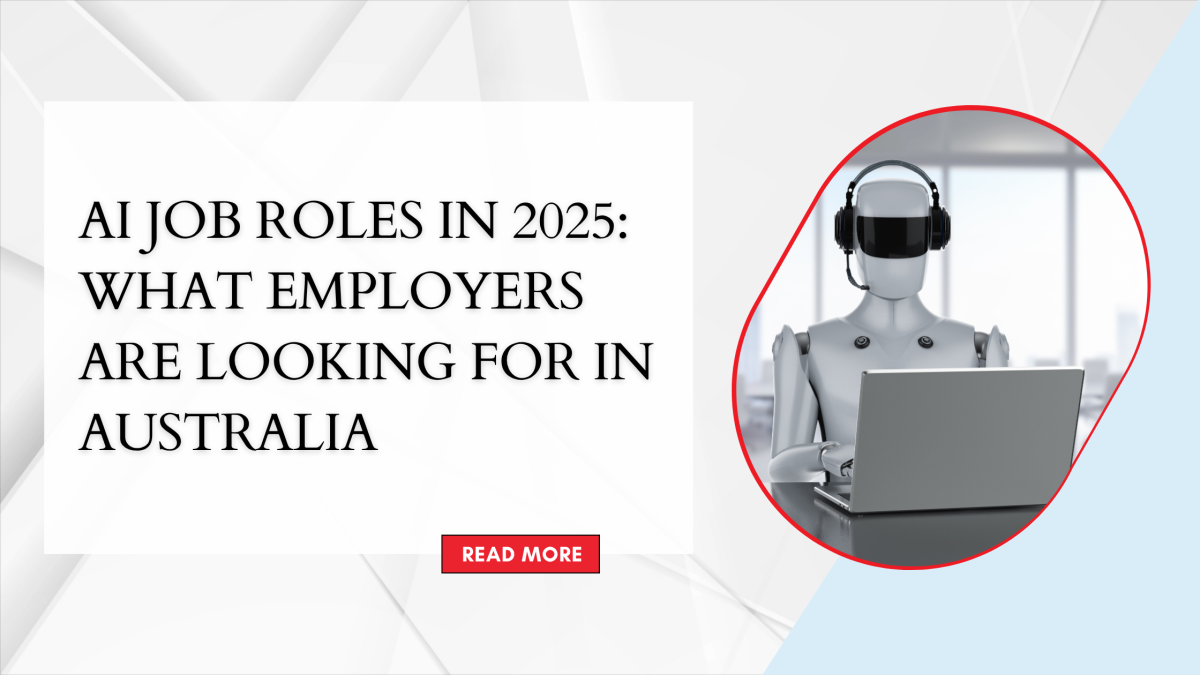AI JOB ROLES IN 2025: WHAT EMPLOYERS ARE LOOKING FOR IN AUSTRALIA

CERTIFICATIONS VS DEGREES: WHAT MATTERS MORE IN IT IN 2025?
28 May 2025
HOW TO WRITE A RESUME THAT GETS NOTICED: TIPS, COMMON MISTAKES & WHAT RECRUITERS WANT
16 June 2025The field of Artificial Intelligence (AI) continues to expand rapidly in 2025, especially in Australia, where demand for skilled AI professionals is growing across sectors like finance, healthcare, government, logistics, and education. As businesses accelerate their digital transformation, IT students and professionals—particularly those pursuing a Bachelor’s in IT—must align their career paths with the evolving AI job landscape.
One of the most strategic ways to enter this domain is by building on foundational roles like Data Analyst or Business Systems Analyst. These positions equip individuals with essential skills in data processing, visualization, and reporting—skills that naturally progress into AI and machine learning roles. This blog explores the top AI job roles in Australia, the technical skills employers seek, and how a data analyst background can serve as a gateway to a thriving AI career.
Key AI Job Roles in Australia (2025)
1. Machine Learning Engineer
Responsibilities:
Building, training, and deploying machine learning models.
Core Tools:
Python, Scikit-learn, TensorFlow, PyTorch, MLOps (Azure ML, MLFlow)
Prerequisites:
Strong grasp of statistics, linear algebra, and data pipelines.
Ideal Path:
Data Analyst → ML Engineer (with added skills in modeling and automation)
2. AI/ML Ops Engineer
Responsibilities:
Automating and scaling ML pipelines in production.
Core Tools:
Docker, Kubernetes, Azure DevOps, Terraform, MLFlow, GitHub Actions
Focus Areas:
CI/CD for ML, model monitoring, versioning, performance tuning
3. Data Scientist
Responsibilities:
Advanced statistical analysis, predictive modeling, and communication of insights.
Core Tools:
Python (Pandas, Numpy), SQL, R, Jupyter, Tableau, Azure Machine Learning
Data Analyst Background Advantage:
Analysts familiar with data pipelines, cleaning, and visualization can pivot into data science by mastering predictive analytics and model building.
4. AI Software Developer
Responsibilities:
Developing software solutions integrating AI APIs or models.
Core Tools:
OpenAI APIs, LangChain, REST APIs, Python/JavaScript
Target Employers:
Startups, SaaS platforms, enterprises embedding AI features in their applications.
5. Prompt Engineer / NLP Engineer
Responsibilities:
Designing high-quality prompts and workflows for LLMs (like ChatGPT).
Core Tools:
HuggingFace, OpenAI API, LangChain, Vector Databases (Pinecone, FAISS)
Desirable Skills:
Python scripting, logic design, understanding of semantic search and embeddings.
6. Computer Vision Engineer
Responsibilities:
Object detection, image classification, OCR, facial recognition systems.
Core Tools:
OpenCV, YOLO, TensorFlow, Azure Cognitive Services

How a Data Analyst Role can lead to AI Careers:
For many IT students in Australia, starting as a Data Analyst offers the most practical and accessible path into AI. This role focuses on collecting, cleaning, and interpreting data to help organizations make informed decisions.
Key skills gained as a Data Analyst include:
SQL Proficiency:
Fundamental for querying and managing data.
Python for Data Analysis:
Critical for automation and preliminary modeling.
Dashboarding & Reporting:
Power BI and Tableau skills are widely used in both analytics and AI reporting.
Data Transformation:
Prepares datasets for more advanced machine learning tasks.
While some institutions may offer structured AI modules, students and professionals can also self-learn AI extensions such as:
Machine Learning Basics:
Using Scikit-learn or online platforms like Coursera, Udemy, or edX.
NLP Fundamentals:
Exploring HuggingFace and simple LLM integrations.
AI APIs:
Experimenting with tools like OpenAI’s GPT, Azure Cognitive Services, and Google Cloud AI.
Free and low-cost resources, online communities, and GitHub repositories make it easier than ever to explore AI independently.
Technical skills that make you AI-ready in 2025
Skill Area
Tools/Tech
Programming
Python, R, SQL
Data Analysis
Pandas, Power BI, Tableau
Machine Learning
Scikit-learn, TensorFlow, PyTorch
DevOps/MLOps
Azure ML, MLFlow, GitHub, Docker, K8s
AI APIs/LLMs
OpenAI API, HuggingFace, LangChain
Cloud Platforms
Azure, AWS, Google Cloud
Version Control
Git, GitHub
Data Storage
SQL, NoSQL, Azure Data Lake
Salary Ranges (approx.):
Data Analyst: AUD $80k–$110k
Data Scientist: AUD $100k–$140k
ML Engineer: AUD $110k–$150k
AI Developer/Prompt Engineer: AUD $95k–$130k
Australia-specific Job Market Trends
Government AI Strategy 2025:
Continued investment in AI for public services.
Healthcare & Finance:
High demand for ML Engineers and Data Scientists.
SMBs & Startups:
Increasing demand for AI-savvy Data Analysts and AI Developers.


The AI job market in Australia is full of opportunity, but it requires a structured and curious mindset. For IT students pursuing bachelor’s degrees and early-career professionals already working with data, taking the next step toward AI is both logical and rewarding.
Even without formal AI training, individuals can build on their data background and use publicly available resources to learn machine learning, AI automation, and advanced analytics. By investing in the right foundational skills today, you’ll be prepared to ride the AI wave and carve a successful career in tomorrow’s digital economy.
Also, read this blog article: Top IT Career Paths in 2025




